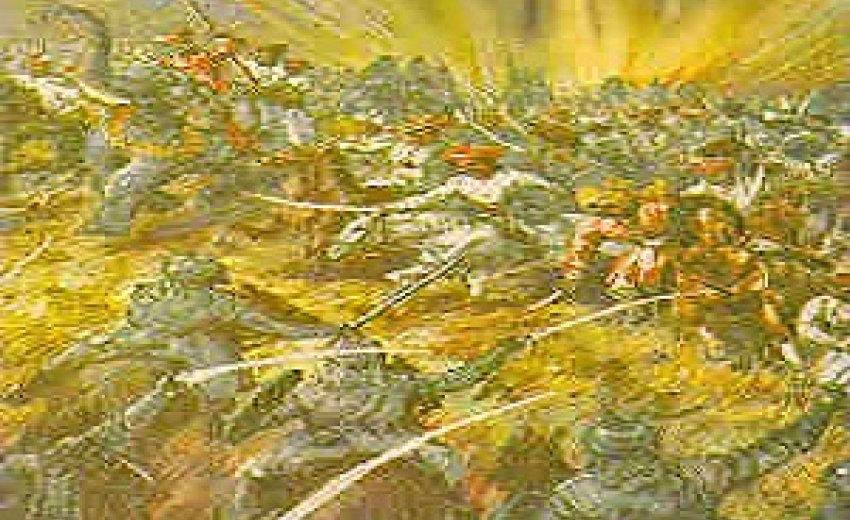
Jan 31, 2011: Two weeks ago, India observed the 250th anniversary of the Third Battle of Panipat. The bloody encounter that took place on 14 January 1761 on India’s most famous battlefield in which Afghans under Ahmad Shah Abdali and their local Muslim allies crushingly defeated the Maratha army. At Panipat, in Puna, and elsewhere in Maharashtra and the rest of India, several events were organised to remember the day and eulogise the Maratha soldiers for their heroic deeds against the foreign invader. Their present-day progeny, among them an Indian Minister of State who is a scion of the Sindia family of Gwalior, were also honoured and shared in the reflected glory of their valiant forebears. A massive monument costing the equivalent of $60 million has been proposed to be set up at the site of the battle.
Displays of patriotic fervor and chest-thumping on such occasions are par for the course all over the world. But in India they are also inevitably used as opportunities for Pakistan-baiting. So there was plenty of finger-wagging at Pakistan during the Panipat anniversary. There were calls to draw inspiration from the battle of Panipat in facing the current enemies of the nation. Gallantry awards named after Maratha heroes of Panipat were handed out to Indian soldiers who took part in military action in Kargil and those who fought against “terrorists” in Kashmir.
There were also some attempts to rewrite history. According to the representative of the Bhonsale clan, one of the five which made up the old Maratha confederacy, the Marathas did not lose the battle as is commonly believed. Instead, they made a strategic withdrawal to save the lives of women and children who were accompanying the Maratha army. This “strategic retreat” was certainly one of the costliest such manoeuvres in military history. According to Bhonsale, nearly 150,000 Marathas were slaughtered in just nine hours on that fateful day. Most estimates put the number of those killed on the Maratha side at about 200,000.
Before the battle, the Marathas had been at the zenith of their power. Their dominions extended over large parts of central India and they were a formidable military power in the north. After the sack of Delhi by Ahmad Shah Abdali (1757), the wazir at the Mughal court had called in the Marathas to restore his authority. From Delhi, the Marathas pushed into the Punjab. The capture of Lahore in April 1758 was followed by the occupation of the whole of Punjab.
In Lahore as in Delhi, the Marathas were now major players. The Puna court began to dream of extending their rule up to Kandahar. The Peshwa talked of ‘leaping over the walls of Attock.’
Since the Marathas saw themselves as representing the resurgent power of the Hindus, the Muslims became alarmed at the advance of Maratha power. Some Muslim rulers wrote to Ahmad Shah Abdali and asked him to save the Muslims from the depredations of the Marathas. Shah Waliullah, the greatest Muslim scholar of his age in India, appealed to Ahmad Shah “to earn the glory of waging a holy war and rescue the Muslims from the hands of unbelievers.” He also urged that “this undertaking should not resemble the invasion of Nadir Shah who destroyed the Muslims and left the Marathas and the [Hindu] Jats intact.”
Ahmad Shah was also eager to recover Punjab, which he had held for some time and which was now in Maratha hands. He had the support of fellow Afghans settled in India like the Rohillas. Shuja-ud-Daulah, the nawab of Awadh, was also won over. In the autumn of 1759, Ahmad Shah invaded India for the fifth time. The Peshwa sent his cousin, Sadashiv Rao, with a formidable force, the largest ever assembled by the Marathas. Besides a large train of artillery, it included a well-ordered cavalry and a disciplined infantry under the command of Ibrahim Gardi, a Muslim general from Deccan who had been trained under the French general Bussy.
Following 18 months of moves and counter-moves, the two armies faced each other at Panipat. For two months, the two sides watched each other. Famine soon began to make itself felt but Ahmad Shah refused to force action because the Maratha army was superior in numbers and equipment. Some of Abdali’s Rohilla allies urged him to make peace but he refused.
At last, driven by hunger, the Marathas on 14 January 1761 threw themselves upon the Afghan army. For a time it seemed that they had triumphed. The Rohillas suffered heavily. Ahmad Shah then ordered up his reserve cavalry. It turned the tide. The Marathas gave way. Their commander and the Peshwa’s son and heir were killed. An awful butchery followed. The Peshwa himself died a few months later, supposedly of a broken heart.
Yet, although the Muslim armies won a resounding military victory at Panipat, it did little to arrest the decline of Muslim political power in India. Ahmad Shah’s soldiers mutinied for their arrears of pay and compelled him to retire to Afghanistan. After this, he and his successors never again got further than Lahore and Punjab gradually slipped from their grasp.
Shuja-ud-Daulah, the Nawab of Awadh, who had nominally been on the side of Abdali, had taken no active part in the battle. He had the Mughal emperor Shah Alam under his wings. Less than four years later, Shuja-ud-Daulah was defeated by the British at Baksar (1764) and became a vassal of the East India Company, while the Moghul emperor became their pensioner.
The Marathas never again attempted to control Punjab. But within 10 years they were back in Delhi, acting as the guardians of the Mughal emperor Shah Alam whom they escorted from Allahabad to Delhi in 1771. In 1785 Shah Alam invited Mahadji Sindia to Delhi and legalised his position with the title of deputy vakil-i-mutlaq or regent of the Empire. With the blinding of Shah Alam in 1788 by a half-mad adventurer, he became a pensioner of Sindia and the Mughal kingdom virtually became a Maratha province.
At Panipat, the two main contenders for power in North India, the Afghans and the Marathas, neutralized each other mutually. The main beneficiaries were two parties who took no part in the battle: the British and the Sikhs. The British had just defeated the French and were destined to become masters of the whole of India, while the ground had been prepared for the Sikhs to gradually take control of Punjab and present-day Khyber Pakhtunkhwa until their own defeat by the British.
The Sikh ascendancy in Punjab was to a large extent made possible by the loosening of authority which resulted from the invasions of Nadir Shah and Ahmad Shah Abdali. After the capture in 1715 of Banda, the “false guru”, by Abdul Samad Khan, the Mughal governor of Lahore, the Sikh armed bands were forced to seek refuge in the foothills of the Himalayas. Little was heard of them in the plains until Nadir Shah’s march to Delhi in 1738-39. From 1948 to 1769 Abdali invaded India nine times, mainly to claim tribute from the local rulers. Punjab bore the brunt of these invasions. This destroyed the Mughal administration of the province, creating a political vacuum in which the Sikhs emerged as the masters of Punjab. From Punjab, Ranjit Singh later conquered Multan and Peshawar as well. Some Sikh historians are therefore of the view that the real victors of Panipat were the Sikhs, and that Abdali, though their bitter foe, unknowingly turned out to be their greatest benefactor.
Such were the long-term consequences of the Third Battle of Panipat. It is as much a part of our history as that of India. But it is a sad reflection that an educated Pakistani today is more likely to be familiar with Napoleon’s campaign to Moscow than with what was one of the bloodiest and most momentous battles of our own history. It is therefore no wonder that the 250th anniversary of Panipat passed unnoticed in the country.
The writer is a former member of the Pakistan Foreign Service. Email: [email protected]

